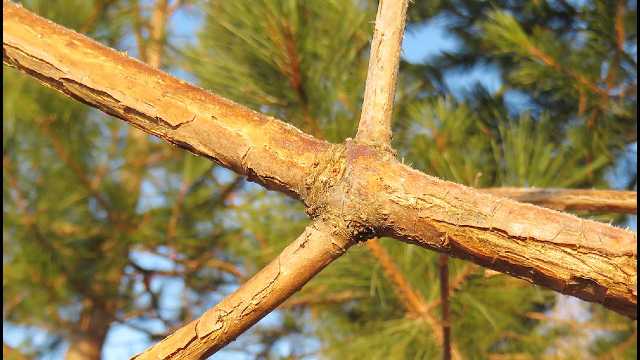By Bill Cook
MSU Extension Forester and Biologist, retired
Bewilderment often greets the dormant season forest visitor in terms of tree identification. However, that’s because most of us have been trained to look at only the leaves and are left unfamiliar with the many other signs.
Once one recalibrates the eyes, the differences among the various tree species pop-out like magic.
If you’re a bit reluctant to totally “leaf” the comfort of leaves, begin with the conifers. Each Lake States conifer, or evergreen, has a unique set of needles. True pines have groups of needles in clusters, fastened at the base by a papery “fascicle”. White pine has five needles in a group, the other pines have two. Red pine has long needles. There are only four common pines; white, red (Norway), jack, and Scots pine. There is porcu-pine, too, but that’s another story.
All other conifers have single needles. These are the two spruces, balsam fir, and hemlock. Cedar “needles” appear more as flattened scales than needles. Tamarack has lost all its needles by the winter solstice but has a fantastical lacy canopy that cannot be mistaken for anything else.
In addition to needles (leaves), there are cones that might be lying around or attached to branches. Bark patterns are also quite distinctive, particularly that of red pine. This leads us to ID of the broad-leaved trees, or hardwoods.
Good winter ID clues include bark and branch patterns, tree form (shape), leaf and flower buds, and growing site. One of the best ways to become more familiar with variety of these characteristics is to focus on the five most common species, sugar maple, red maple, quaking aspen, bigtooth aspen, and “oaks”. Now, “oaks” consist of a bunch of species but they often look similar to each other. More on that later.
The “uptreeid.com” website illustrates all the specifics that cannot easily fit into a single newspaper article.
The maples have “opposite” branching, meaning a pair of twigs (or twig stubs or scars) grow on opposite sides of a central twig. This pattern jumps out after a bit of observation, assuming the twigs aren’t fifty feet up in the air! Ashes and a short list of other tree species also have opposite branches, but maples dominate in terms of numbers and volumes.
Once “maple” has been found, the buds easily distinguish sugar from red maple. Sugar maple buds are sharp. Red maple buds are rounded, and last summer’s twigs are reddish. Red maple may also have red clusters of flower buds.
Bark patterns also distinguish these common maples, although this takes more practice and exposure. Bark patterns vary with tree age, but the progression of sugar maple bark patterns is different from that of red maple.
The aspens, or popples, stand-out with their light-colored, mostly smooth, bark. Both species have a range of hues, which sometime overlap a bit. Quaking aspen is generally whiter or grayer. Bigtooth aspen often has an olive tinge. Their bark can photosynthesize, which is a bit unusual for northern trees.
As the bark colors and patterns become discernible, differences in bud shapes and colors will confirm the difference between the aspen species.
Then there are the oaks, a sometimes confusing collection of similar species. First, there are species in the “red oak” subgroup, and others in the “white oak” subgroup.
During the summer, pointy-tipped leaves indicate red oaks and blunt-tipped leaves the white oaks. Red oaks tend to have darker gray bark, while white oaks are lighter and “corkier”.
Oaks have clusters of buds at the ends of twigs, rather than single buds. The arrangement, shape, and color of the buds are unique to each species, although the differences are sometimes rather subtle.
If acorns can be found, and correctly associated with a tree, they are great clues. Different sites and soils will often support one oak over another. For oak ID, one might be satisfied with the correct subgroup placement.
To add to the head-scratching, “red oak” and “white oak” are individual species names as well as subgroup categories. The most common oaks in the Lake States are northern red oak and white oak. Learning their characteristics will put you on the road to oak identification.
Site conditions determine which tree species are likely to be found and tree species often have common associates. If there are lots of sugar maple, you’ll likely find basswood, yellow birch, and beech. If the site is wetter, you might start thinking about (dead) ash, elms, and red maple, or mixes of black spruce, tamarack, and cedar.
Tree ID is rich with features, some of them peculiar and readily diagnostic for a species. Twigs with dark black swellings (cankers) suggest one of the three wild cherries. Bright white peeling bark is, of course, paper birch. A graceful vase-shaped form is likely to be American elm. A conifer with a very pointy crown will likely be balsam fir or, perhaps, white spruce. Really long and sharp cigar-shaped buds tell you that you’ve found beech.
All tree species have flowers and fruits. In early spring, before leaf-out, flowers might help with tree ID. In the dormant season, one might find fruits, or pieces of fruits, that can lead to correct ID.
Lastly, some species retain a portion of their browned leaves well into the winter. This is especially true for beech and ironwood. Young red oaks will usually have a few persistent leaves in the understory, somewhat protected from wind.
Once one becomes fluent in the language of tree characteristics, tree ID actually becomes easier in the winter than in the summer. Successful discovery can also be quite satisfying, one more thing to enjoy while on a stroll, on skis, or marching along on snowshoes.












